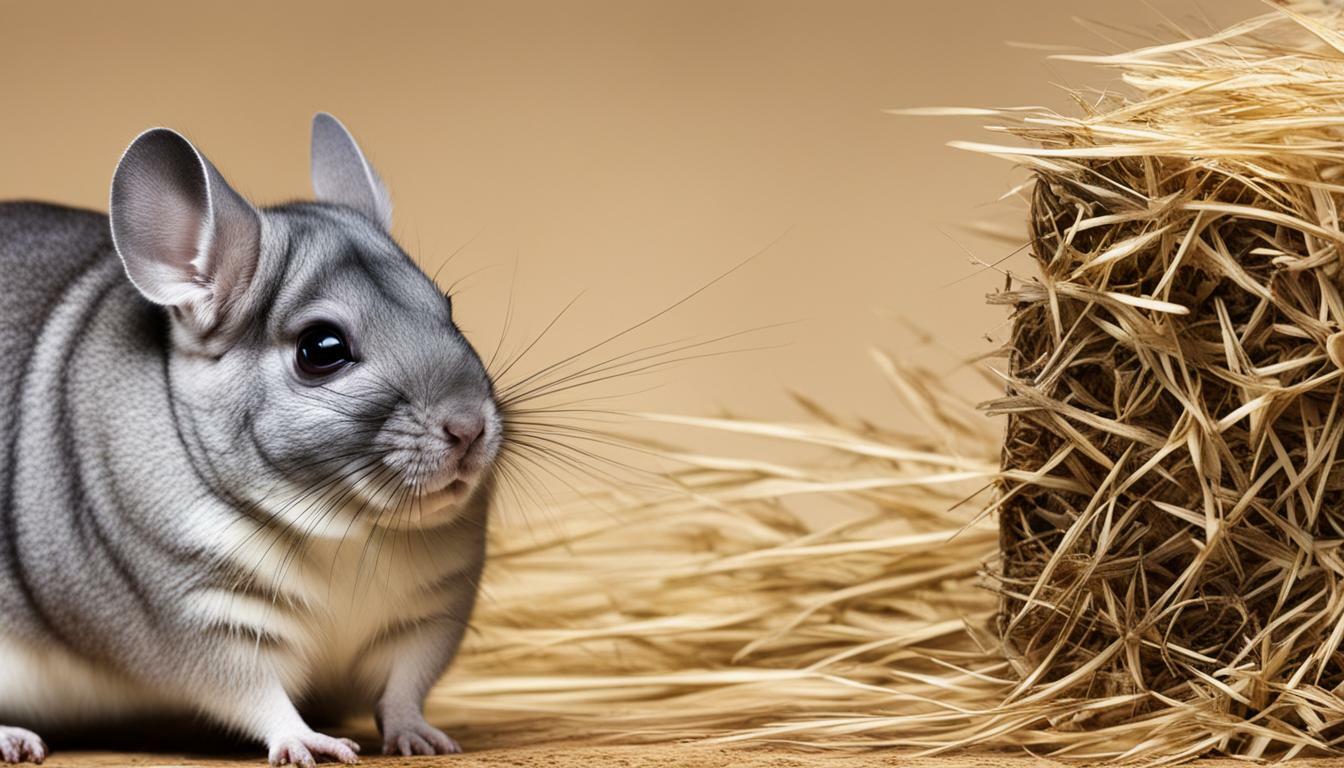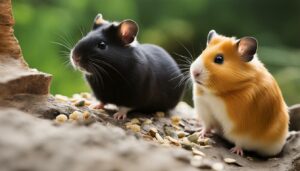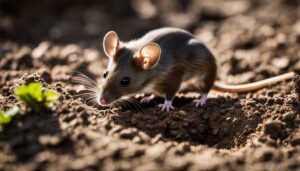Chinchillas are generally known for their dense fur, but can they actually get fleas? While it is rare, chinchillas can indeed be susceptible to flea infestations, especially in areas with thinner fur such as the ears, face, tail, belly, thighs, and feet. It’s important for chinchilla owners to be aware of the possibility of fleas and take preventive measures to ensure their furry friends stay healthy and happy.
Key Takeaways:
- Chinchillas can get fleas, although it is rare due to their dense fur.
- Fleas may be able to access areas with thinner fur such as the ears, face, tail, belly, thighs, and feet.
- Chinchillas can catch fleas from other household pets that go outside, such as cats and dogs.
- Signs of flea infestation in chinchillas include flea dirt (excrement), skin irritation, and hair loss.
- It is important to seek veterinary advice for flea treatment options, as over-the-counter flea treatments and flea collars can be harmful to chinchillas.
Understanding Flea Infestations in Chinchillas
Flea infestations can occur in chinchillas, even though their dense fur provides some protection. While chinchillas are not as prone to fleas as other animals, they can still be affected, especially in areas with thinner fur such as the ears, face, tail, belly, thighs, and feet. It’s important to understand the signs of flea infestation and take appropriate measures to ensure your chinchilla’s well-being.
One of the key signs of flea infestation in chinchillas is the presence of flea dirt, which is the excrement left behind by fleas. This can usually be seen as small black specks on your chinchilla’s fur or bedding. Another indication of fleas is skin irritation, with your chinchilla constantly scratching or biting at affected areas. Hair loss can also occur, particularly in severe cases of infestation.
If you suspect your chinchilla has fleas, it is crucial to seek veterinary advice for proper diagnosis and treatment options. Over-the-counter flea treatments and flea collars designed for other animals can be harmful to chinchillas. A veterinarian will be able to recommend safe and effective flea treatment specifically tailored for your furry friend.
Prevention is always better than cure when it comes to flea infestations. Regular hygiene practices play a significant role in keeping your chinchilla flea-free. This includes cleaning the cage on a regular basis, offering dust baths to help keep their fur clean, and maintaining a clean environment overall. Regular grooming and flea control are essential for maintaining your chinchilla’s health and well-being.
| Signs of Flea Infestation in Chinchillas: |
|---|
| Flea dirt: Small black specks on fur or bedding |
| Skin irritation: Constant scratching or biting |
| Hair loss: Particularly in severe cases |
Sources of Fleas in Chinchillas
Chinchillas can catch fleas from other pets in your household, especially if they have access to the outdoors. Fleas are tiny parasites that can easily hitch a ride on cats and dogs, and if these pets come into contact with your chinchilla, there’s a chance that the fleas may transfer onto your furry friend as well.
When it comes to preventing flea infestation in chinchillas, it’s essential to take proactive measures. One of the most effective ways to keep fleas away from your chinchilla is to ensure that all pets in your household are regularly treated for fleas. This includes using flea preventatives such as monthly spot-on treatments or oral medications, as recommended by your veterinarian.
Additionally, it’s important to limit your chinchilla’s contact with other pets that go outdoors. Fleas are commonly found in grassy areas, so if your chinchilla comes into contact with other animals that have been roaming outside, there is a higher risk of flea transmission. Keeping your chinchilla indoors or in a controlled, flea-free environment can significantly reduce the chances of flea infestation.
| Preventive Measures | Description |
|---|---|
| Regular Flea Treatments | Ensure that all pets in your household receive regular flea treatments as recommended by your veterinarian to prevent flea infestation. |
| Limited Outdoor Access | Limit your chinchilla’s contact with other pets that go outdoors to reduce the risk of flea transmission. Keeping your chinchilla indoors or in a controlled environment can help prevent flea infestation. |
| Safe, Clean Living Environment | Maintain a clean living environment for your chinchilla, regularly cleaning their cage and surroundings. Vacuuming the area can help eliminate any fleas or eggs that may have been brought in from the outside. |
By taking these preventive measures, you can significantly reduce the risk of flea infestation in your chinchilla and ensure their health and well-being.
Recognizing Signs of Flea Infestation
It’s important to be aware of the signs of flea infestation in chinchillas to ensure their well-being. Although chinchillas have dense fur that often deters fleas, these pesky insects can still find their way into areas with thinner fur, such as the ears, face, tail, belly, thighs, and feet. To help you identify whether your chinchilla has a flea problem, here are some key signs to watch out for:
- Flea dirt (excrement): Look for small black specks resembling pepper flakes on your chinchilla’s fur. These specks are actually flea feces and can be a tell-tale sign of infestation.
- Skin irritation: Fleas can cause itching and redness on your chinchilla’s skin. Keep an eye out for excessive scratching or rubbing against objects, as well as any signs of inflammation.
- Hair loss: If your chinchilla is experiencing hair loss, particularly around the areas where fleas tend to congregate, it could be a sign of flea infestation.
“It’s crucial to seek veterinary advice when dealing with flea infestations in chinchillas.”
If you suspect that your chinchilla may have fleas, it’s crucial to seek veterinary advice. While over-the-counter flea treatments and flea collars may seem like a quick fix, they can actually be harmful to chinchillas due to their sensitive nature. A veterinarian will be able to recommend safe and effective treatment options that specifically cater to chinchillas.
In addition to seeking professional advice, maintaining good hygiene practices is essential when it comes to flea control in chinchillas. Regularly cleaning your chinchilla’s cage, providing dust baths, and keeping their environment clean can help prevent flea infestations and keep your furry friend healthy. Remember, prevention is key!
| Flea Infestation Signs | Description |
|---|---|
| Flea dirt (excrement) | Small black specks resembling pepper flakes on the fur |
| Skin irritation | Itching, redness, and inflammation |
| Hair loss | Especially around areas where fleas congregate |
Seeking Veterinary Advice for Treatment
When it comes to flea treatment for chinchillas, it’s crucial to consult a veterinarian for the best approach. Chinchillas are unique animals with specific needs, and using over-the-counter flea treatments or flea collars can put their health at risk. A veterinarian can provide expert guidance on safe and effective flea control options tailored to your chinchilla’s individual needs.
In the case of flea infestation, a veterinarian will be able to accurately diagnose the problem and recommend appropriate treatment. They may prescribe a topical medication or oral medication specifically designed for chinchillas. These medications are formulated to effectively eliminate fleas while ensuring the safety of your pet.
Additionally, a veterinarian can provide valuable advice on preventive measures to keep your chinchilla flea-free. Regular grooming, including combing through your chinchilla’s fur to remove any fleas or flea dirt, is an important step in preventing infestations. Your veterinarian can teach you proper grooming techniques and recommend suitable chinchilla-safe grooming tools.
Remember, the health and well-being of your chinchilla should always be a top priority. By seeking veterinary advice for flea treatment and prevention, you can ensure that your furry friend remains happy and free from flea-related discomfort.
Importance of Regular Hygiene Practices
By implementing regular hygiene practices, you can significantly reduce the risk of flea infestations in your chinchilla. These small and adorable creatures have dense fur that can make it difficult for fleas to establish a home. However, areas with thinner fur, such as the ears, face, tail, belly, thighs, and feet, provide an opportunity for fleas to find their way onto your chinchilla.
To maintain a clean and flea-free environment for your chinchilla, it is essential to keep their cage tidy. Regularly remove any soiled bedding, feces, or urine to prevent the buildup of bacteria and parasites. Consider using bedding options that are less prone to harboring fleas, such as fleece or paper-based bedding.
In addition to cage cleaning, offering a regular dust bath to your chinchilla is crucial for their hygiene and flea control. Chinchillas have specialized fur that requires regular dusting to remove excess oils and keep their coat in optimal condition. Dust baths not only help in removing potential flea eggs or larvae but also provide a fun and stimulating activity for your furry friend.
| Hygiene Practices to Prevent Fleas in Chinchillas: |
|---|
| Regularly clean the chinchilla’s cage, removing soiled bedding. |
| Consider using bedding options less prone to fleas, such as fleece or paper-based bedding. |
| Offer a regular dust bath to remove excess oils and potential flea eggs or larvae. |
Remember, prevention is key when it comes to flea control in chinchillas. By practicing good hygiene habits and providing regular dust baths for your chinchilla, you can minimize the risk of flea infestations and ensure their overall health and well-being.
Protecting Your Chinchilla’s Home
Creating a flea-proof environment is crucial for keeping your chinchilla safe and healthy. Fleas can pose serious health risks to your furry friend, causing discomfort and potentially leading to infections. By implementing a few preventive measures, you can significantly reduce the chances of flea infestations and ensure your chinchilla’s well-being.
Regular cleaning routines: Maintaining a clean cage is essential in preventing flea infestations. Regularly remove any waste, uneaten food, and soiled bedding. Wipe down the cage with a pet-safe disinfectant, paying close attention to corners and crevices where fleas may hide. Vacuuming the surrounding area near the cage can also help eliminate fleas and their eggs.
Choosing suitable bedding: Opt for bedding materials that are less likely to harbor fleas. Hardwood shavings or paper-based bedding are better options compared to materials like straw, cotton, or fabric, which can provide hiding places for fleas. Additionally, using a bedding that is treated with flea-repellent additives can further enhance flea prevention.
| Flea Prevention Tips | |
|---|---|
| Regularly clean the chinchilla’s cage | Use a pet-safe disinfectant and vacuum the surrounding area |
| Choose suitable bedding | Opt for hardwood shavings or paper-based bedding |
| Offer regular dust baths | Use chinchilla-specific dust that can help remove fleas and prevent infestation |
| Keep other pets treated | Ensure that cats and dogs in the household are flea-free |
“Regular cleaning routines and suitable bedding choices are key in maintaining a flea-free environment for your chinchilla.”
Regular dust baths: Chinchillas rely on dust baths for their grooming routine and to keep their fur clean. Using chinchilla-specific dust in a designated dust bath area can help remove fleas and prevent infestation. The dust suffocates and eliminates fleas while keeping your chinchilla’s coat healthy and free from pests.
Keep other pets treated: If you have other pets in your household, such as cats or dogs, it is important to ensure they are regularly treated for fleas. These pets can bring fleas into the environment, putting your chinchilla at risk. Talk to your veterinarian about safe and effective flea prevention products for your furry companions.
By implementing these preventive measures and maintaining a clean and hygienic living space for your chinchilla, you can minimize the risk of flea infestation and keep your chinchilla happy and healthy.
Understanding Chinchilla Flea Control Products
Understanding the various flea control products for chinchillas can help you select the right option for your pet. Fleas can be a nuisance and can cause discomfort and health issues for your chinchilla. Therefore, it’s important to take proactive measures to prevent flea infestations and properly treat your chinchilla if it does become infested.
When it comes to flea control products for chinchillas, there are a few options available. One common method is the use of topical treatments that are applied directly to your chinchilla’s skin. These treatments typically contain active ingredients that kill fleas and prevent future infestations. It’s important to carefully follow the instructions provided by the manufacturer and consult with your veterinarian to ensure the product is safe and suitable for your chinchilla.
Another option for flea control in chinchillas is the use of flea sprays specifically formulated for small animals. These sprays can be applied to your chinchilla’s fur, bedding, and habitat to kill fleas and prevent reinfestation. Be sure to choose a spray that is safe for use on chinchillas and follow the instructions carefully to avoid any adverse effects on your pet.
In addition to topical treatments and sprays, there are also flea combs available for chinchilla flea control. These combs have fine teeth that can effectively remove fleas and flea dirt from your chinchilla’s fur. Regular combing can help control fleas and reduce the risk of infestation. It’s important to handle your chinchilla gently while using the comb and dispose of any fleas or flea dirt properly.
| Product Type | Recommended Use | Precautions |
|---|---|---|
| Topical Treatments | Apply directly to the skin to kill fleas and prevent future infestations. | Consult with your veterinarian to ensure safety and suitability. |
| Flea Sprays | Apply to fur, bedding, and habitat to kill fleas and prevent reinfestation. | Choose a spray that is safe for chinchillas and follow instructions carefully. |
| Flea Combs | Regularly comb your chinchilla’s fur to remove fleas and flea dirt. | Handle your chinchilla gently and dispose of fleas or flea dirt properly. |
Remember, when selecting a flea control product for your chinchilla, always prioritize their safety and consult with your veterinarian for guidance. Every chinchilla is unique, and what works for one may not necessarily work for another. By understanding the various flea control products available and adopting preventive measures, you can help ensure the health and well-being of your beloved chinchilla.
Maintaining a Flea-Free Environment
In addition to treating your chinchilla, it’s important to create a flea-free environment in your home. By implementing regular hygiene practices and taking preventive measures, you can help ensure the health and well-being of your furry friend. Here are some tips to help you maintain a flea-free environment for your chinchilla:
- Clean the cage: Regularly clean your chinchilla’s cage to remove any potential flea eggs or larvae. Use a pet-safe disinfectant and thoroughly dry the cage before placing your chinchilla back inside.
- Offer dust baths: Chinchillas naturally groom themselves by taking dust baths. Providing a dust bath at least once a week can help keep fleas at bay, as the dust will suffocate and eliminate any parasites on your chinchilla’s fur.
- Keep the environment clean: Vacuuming your home frequently can help prevent flea infestations. Pay extra attention to areas where your chinchilla spends time, such as their play area or bedding. Dispose of the vacuum bag immediately to avoid any potential reinfestation.
- Use pest control measures: Consider using pet-safe pest control products in your home, especially in areas where your chinchilla roams. Consult with a veterinarian to find the most suitable and safe options for your chinchilla’s environment.
By following these practices, you can minimize the risk of fleas in your chinchilla’s environment and create a safe and comfortable space for them to thrive. Remember, prevention is key when it comes to flea control, so be proactive in maintaining a flea-free environment for your beloved chinchilla.
| Preventive Measures | Benefits |
|---|---|
| Regular cage cleaning | Eliminates potential flea eggs and larvae |
| Dust baths | Suffocates and eliminates fleas on your chinchilla’s fur |
| Frequent home cleaning | Reduces the chance of flea infestation |
| Pest control measures | Provides additional protection against fleas in the environment |
Educating Yourself on Chinchilla Flea Prevention
By educating yourself on chinchilla flea prevention, you can take proactive steps to protect your pet. Fleas can pose a risk to your chinchilla’s health and well-being, so it’s important to be knowledgeable about how to prevent infestations. Here are some key tips to keep in mind:
- Regular grooming: Regularly grooming your chinchilla can help remove any fleas or flea dirt present on their fur. Use a soft brush or comb to gently groom their dense fur, paying extra attention to areas with thinner fur such as the ears, face, and tail.
- Clean environment: Maintaining a clean environment is crucial for preventing flea infestations. Clean your chinchilla’s cage regularly, removing any debris or waste that may attract fleas. Additionally, consider using chinchilla-safe cleaning products to ensure a hygienic living space for your pet.
- Pest control measures: Taking preventive measures against fleas in your home can help protect your chinchilla. Vacuuming regularly can help eliminate any fleas or eggs that may be hiding in carpets or furniture. You can also consider using pet-friendly flea control products in your home, following the instructions carefully to ensure your chinchilla’s safety.
Choosing the Right Flea Control Products
When it comes to flea control products for chinchillas, it’s essential to choose the right ones to avoid any harm to your pet. Always consult with a veterinarian before using any flea treatments on your chinchilla, as they can recommend safe and effective options. Avoid using over-the-counter flea treatments or flea collars, as they may contain ingredients that can be toxic to chinchillas.
| Treatment Method | Effectiveness | Safety |
|---|---|---|
| Prescription spot-on treatments | Highly effective | Safe when used as directed |
| Prescription oral medications | Effective | Safe when used as directed |
| Natural remedies | Variable effectiveness | May be safe, but research thoroughly and consult with a veterinarian |
Remember, prevention is key when it comes to flea control in chinchillas. By taking proactive steps, maintaining a clean environment, and seeking professional advice, you can ensure that your chinchilla stays healthy, happy, and free from fleas.
Conclusion
Understanding the risks and implementing preventive measures will help keep your chinchilla flea-free and healthy. While it is rare for chinchillas to get fleas due to their dense fur, it is still important to be aware of the possibility and take steps to protect your furry friend.
Fleas can access areas with thinner fur, such as the ears, face, tail, belly, thighs, and feet, so it’s crucial to regularly check these areas for any signs of infestation. Keep an eye out for flea dirt, which appears as small black specks on your chinchilla’s fur. Additionally, if you notice any skin irritation or hair loss, it could be a sign of a flea problem.
If you suspect that your chinchilla has fleas, it’s essential to seek veterinary advice for the right treatment options. Avoid using over-the-counter flea treatments or flea collars, as they may contain ingredients that can harm your chinchilla. Your veterinarian will be able to recommend safe and effective flea control methods for your pet.
Regular hygiene practices are key in preventing flea infestation. Keeping your chinchilla’s cage clean and providing regular dust baths will help remove any existing fleas and prevent new ones from taking hold. Remember to clean the entire environment, including bedding and accessories, to maintain a flea-free living space for your chinchilla.
By staying informed about chinchilla flea prevention and taking proactive measures, you can ensure the well-being and health of your chinchilla. Stay vigilant, keep your chinchilla’s home clean, and seek professional guidance when needed. With proper care, you can enjoy a flea-free life with your chinchilla companion.
FAQ
Can chinchillas get fleas?
Yes, chinchillas can get fleas, although it is rare due to their dense fur.
Where can fleas access on a chinchilla’s body?
Fleas may be able to access areas with thinner fur such as the ears, face, tail, belly, thighs, and feet.
How do chinchillas catch fleas?
Chinchillas can catch fleas from other household pets such as cats and dogs that go outside.
What are the signs of flea infestation in chinchillas?
Signs of flea infestation in chinchillas include flea dirt (excrement), skin irritation, and hair loss.
What should I do if my chinchilla has fleas?
It is important to seek veterinary advice for treatment options, as over-the-counter flea treatments and flea collars can be harmful to chinchillas.
How can I prevent flea infestation in my chinchilla?
Regular hygiene practices, such as cleaning the cage and offering dust baths, can help prevent flea infestation.




